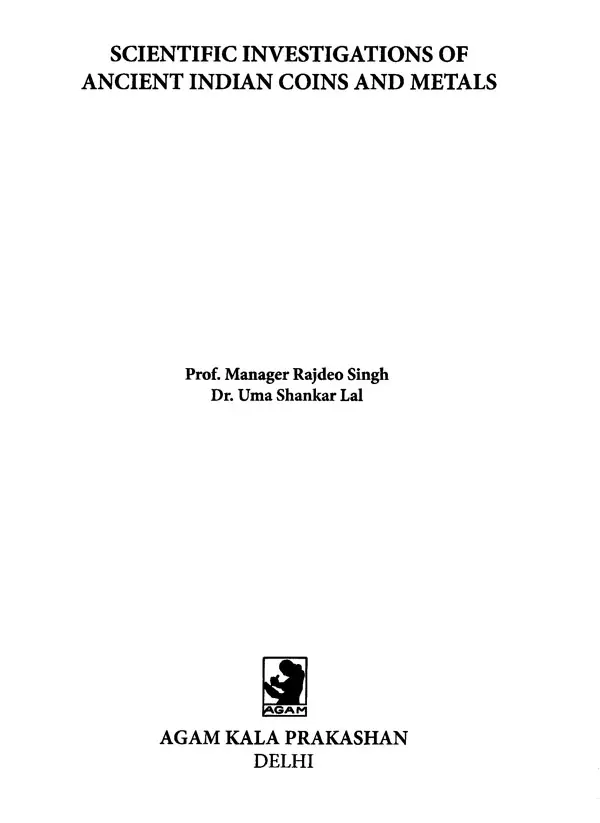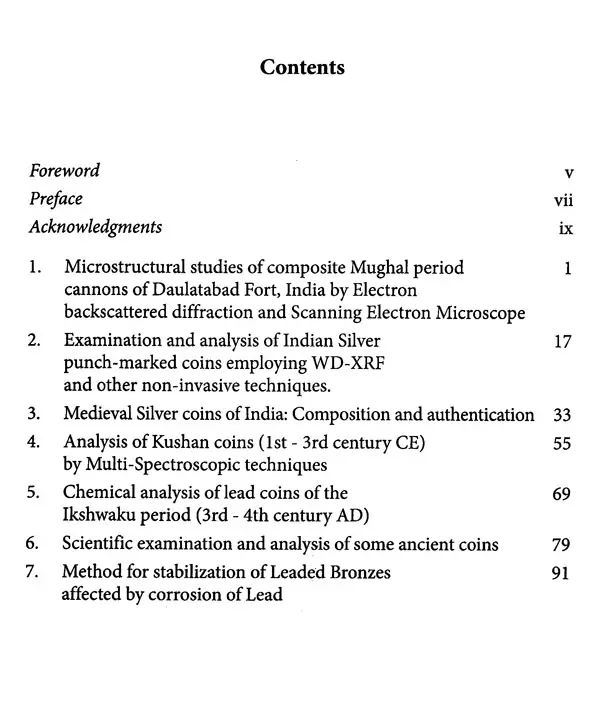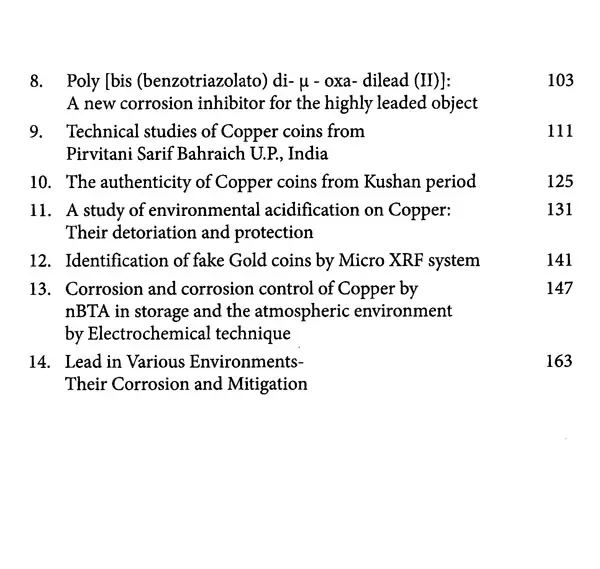
Scientific Investigations of Ancient Indian Coins and Metals
Book Specification
| Item Code: | UAM207 |
| Author: | Rajdeo Singh and Uma Shankar Lal |
| Publisher: | Agam Kala Prakashan, Delhi |
| Language: | English |
| Edition: | 2019 |
| ISBN: | 9788193845721 |
| Pages: | 172 (Throughout B/W Illustrations) |
| Cover: | HARDCOVER |
| Other Details | 9.50 X 6.00 inch |
| Weight | 450 gm |
Book Description
This book exclusively deals about the various advance instrumental techniques applied for the examination of historic Indian coins for their composition and microstructure. Based on the authors' more than 37 years of experience in the field of metal conservation, the book highlights the type and source of minerals for minting the coins, fabrication technology and discrimination between the fake and old coins based on scientific examinations. Few newer methods for the preservation of ancient coins, leaded bronzes, and metal artifacts have been highlighted based on field trial. The book also incorporates about the cannon metal and fabrication technology used for bimetallic medieval cannons using advanced instrumental techniques like Electron Back scattered Diffraction (EBSD) and Scanning Electron Microscope (SEM). The authors have compiled all their international and national publications for this book project for the benefit of researchers, metal conservators and scientific institutions working in the field of metals and alloys.
Dr. Manager Rajdeo Singh is presently working as professor and head, Department of Conservation, National Museum Institute, Janpath, New Delhi-110011. He has worked for about 37 years in various capacity in other central government organization and retired on 31.12.2015 as superintending Archaeological Chemist, Archaeological Survey of India, Science branch, Aurangabad, He has authored around 80 research papers published in various international/ national journals on various topics of archaeological conservation/ ancient material science. He has also authored five books published by international/ national publishers. He was associated with the conservation of Cave murals of Ajanta/Ellora, Goa Churches and monuments of Maharashtra and Goa for a long time and contributed immensely towards conservation of mural arts in India.
Dr. U.S. Lal, is well known professional in the field of conservation cultural heritage and author of this book entitled “Ancient Bronzes: History, Metallurgy, Corrosion and Conservation”. Dr. Lal obtained his M.Sc., Ph.D, degree from University of Allahabad. Allahabad. At present he is Senior. Scientist and Head of Department of Analytical and Metal Research Division in National Research Laboratory for Conservation of Cultural Property (NRLC), Lucknow, India, a premier institution devoted to conservation research and conservation of cultural heritage. Dr. Lal visited Rome (Italy) as UNESCO fellow and got specialised training in SEM and EDX at Eindhoven, The Neitherland. He has published more than 60 research papers in National and International journals in metal conservation and edited various proceedings and publications. His primary areas of research are ancient metallic artifacts, corrosion inhibitors, characterisation of corrosion products, pigments and air quality monitoring.
The book "Scientific Investigations on Ancient Indian Coins and Metals" intend to provide researchers and conservation professionals about materials and manufacturing technology of ancient coins of different periods. The book particularly provides micro-structured studies of coins, its authentication and metal artefacts curative treatment. Manufacturing of fake coins and its identification through scientific investigations have also been detailed in the book. The texture, composition and minting technology of ancient coins and metals artefacts have been investigated through sophisticated instruments like SEM EDX, EBSD, WD-XRF, XRD, metallographic examinations, etc. This has revealed the manufacturing techniques, hoards and minerals used in the manufacturing process. Some new conservation methodology for bronze disease and high leaded bronzes infected by corrosion have also been reported for the benefit of conservators of metal artefacts. Besides, development of cannon technology specifically bi-metallic cannons in India has been highlighted. This book is the result of more than 35 years of practical work and research experiences of the authors on original metal artefacts.
We hope that after reading the book the conservation professionals and researchers would gain practical knowledge which will be entirely different to the bookish knowledge that a research scholar may attain in an institution.
The authors wish to thank the colleagues from Archeological Survey of India, Dr. Vinod Kumar and Nilesh Mahajan and research fellows from National Museum Institute, New Delhi namely Dr. Aditya Kanth, Bhushan Dighe, Anjali, Rekha who actively participated in the project. We especially thank Ms. Tahseen Karche, a Research assistant at National Museum Institute for her extraordinary interest and help in the shaping of this book. We also thank Mr. Ghanshyam Lal, Ms. Aprajita Singh, Research scholar, Scientific staff and institutions providing objects for study and research.
It gives me immense pleasure to write the foreword for the book titled 'Scientific Investigations of Ancient Indian Coins and Metals' authored by Dr. U.S. Lal. This book is outcome of the authors' 30 years of research experience in the field of metal conservation culminating investigative approach and developing safe methods for curative conservation. These articles, originally published in specialized international and national journals, are not easily accessible to readers and researchers working in the field. The core theme of the book is the guide-lines that have evolved in various disciplines of metal conservation e.g. non-invasive techniques for examination., newer methods for treating bronze disease and developing corrosion inhibitor for high leaded bronzes. It is my hope expectation that the book will provide an effective learning experience and reference resources for all conservation professionals, caring for ancient metals and coins. The articles illustrating authenticity of ancient coins non-invasively would provide in-depth knowledge to museum managers while deciding the procurrement of objects for their collection.
**Contents and Sample Pages**
















